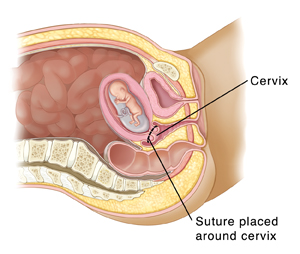Pregnancy and Childbirth: Transvaginal Cerclage
Your healthcare provider suggests that you have a cerclage. This is a procedure to close the cervix during a pregnancy. It's done if you have a weak cervix. It is to help prevent miscarriage or preterm birth. A weak cervix is known as cervical insufficiency. Miscarriage is loss of a baby early in pregnancy. Preterm birth is delivery before the 37th week. Transvaginal cerclage is done by putting a stitch in the cervix to close it. Read on to learn more.
The cervix and pregnancy
The uterus (womb) is where the baby grows during pregnancy. The cervix is the opening from the uterus into the vagina. The cervix normally stays firmly closed until the baby is ready to be born. A short or weak cervix may not stay closed as the baby grows larger. This is called cervical insufficiency. It is also called incompetent cervix. If the cervix opens too soon, you may have a miscarriage or preterm birth.
How cervical cerclage works

The goal of a cerclage is to hold the cervix closed. This lets the baby fully grow before birth. Cerclage is done at about week 12 of the pregnancy. The healthcare provider gets to the cervix through your vagina. They put a stitch in the cervix. At week 37, the baby should be ready for life outside the womb. At this time, the provider removes the stitch. This lets the cervix open when labor starts. Once you have a cerclage, you will likely need this for each future pregnancy.
Risks and possible complications of transvaginal cerclage
The procedure is considered safe. But like all procedures, it has some risks. These include:
Preparing for the procedure
How to get ready for the procedure:
-
Tell your healthcare provider about all medicines you take. This includes over-the-counter medicines. It includes vitamins and pain medicines.
-
Don't put anything in your vagina for 24 hours before the procedure. Don't have sex.
-
Don't eat or drink anything after midnight the night before the procedure. This includes water. If you have diabetes, ask your provider if you need other instructions.
The day of the procedure
Here is what to expect:
-
An IV (intravenous) line is placed in your hand or arm. It sends fluids and medicine into your body.
-
You will be given anesthesia. This is medicine to keep you free of pain. It may make you relaxed, drowsy, or fully asleep. You may be given spinal anesthesia. This will make you numb from the waist down.
-
A tool called a speculum is put into your vagina to hold it open.
-
Local anesthesia may be injected into the cervix to numb it.
-
The healthcare provider puts small tools into the vagina. These are used to stitch the cervix closed. Surgical thread is used. Knots are made to hold the thread tight. The thread may be wrapped around the cervix and pulled tight. This thread will be cut later in your pregnancy.
After the procedure
Here is what to expect:
-
You will be taken to a room to recover from the anesthesia. Nurses will check on you as you rest.
-
You will be watched for signs of preterm labor. You will be given medicine that helps prevent preterm labor.
-
Your baby’s heart rate will be watched.
-
You will have some light bleeding and cramping. This is normal. You will likely be given pain medicine. If you are still in pain, tell the nurse.
-
You may be able to go home later that day. Or you may stay overnight in a hospital room. This is to make sure you don't go into preterm labor. When you leave the hospital, have an adult friend or family member drive you home.
Recovering at home
Tips for home recovery include:
-
You may be prescribed medicine to take at home. This may be medicine to relieve pain. It may also be medicine to prevent labor. Take all medicines as prescribed.
-
Take it easy for 2 to 3 days after the procedure. Plan to have others help you as needed. Unless you are told to do so, you don't need to stay in bed.
-
Don't have sex for at least 7 days after the procedure.
-
Ask your healthcare provider when you can go back to work. Ask when you can exercise.
Follow-up care
During your follow-up visit, your healthcare provider will check your healing. You can talk about how your pregnancy is going. You'll be told when to schedule an appointment to have the stitch removed.
When to call the healthcare provider
Call your healthcare provider if you have any of these:
-
A fever of 100.4°F (38°C) or higher, or as advised by your provider
-
Pain that doesn't go away even after taking pain medicine
-
Contractions or stomach cramping
-
Fluid leaking from the vagina
-
Bleeding or spotting of blood from the vagina
-
Bad-smelling fluid from the vagina
-
Back or stomach pain